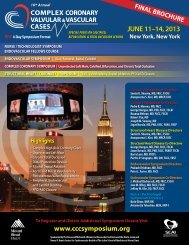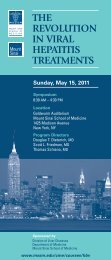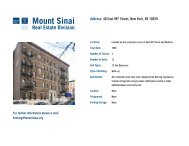David H. Koch Donates $10 Million to Jaffe Food Allergy Instituterecruitment of leading scientists will helpestablish a robust team dedicated to foodallergy therapeutics. Mr. Koch is ExecutiveVice President of Koch Industries, and aKenneth L. Davis, MD, President and ChiefExecutive Officer of The <strong>Mount</strong> <strong>Sinai</strong> MedicalCenter, says, “Breakthrough therapeutics suchas these will change the face of children’sMy hope is that in the not-too-distant future,children who suffer from life-threatening foodallergies will have their lives transformed from thetherapies that originated here.— David H. KochDavid H. KochPhilanthropist David H. Koch recentlydonated $10 million to the Jaffe FoodAllergy Institute at The <strong>Mount</strong> <strong>Sinai</strong> MedicalCenter, to create the David H. and JuliaKoch Research Program in Food AllergyTherapeutics. The program will serve as a hubfor drug discovery related to food allergies,and build upon the promising work alreadyunder way at <strong>Mount</strong> <strong>Sinai</strong>. The additionalmajor advocate for medical research. The giftrepresents one of the largest donations evermade to the Jaffe Food Allergy Institute.Hugh A. Sampson, MD, Kurt HirschhornProfessor of Pediatrics, Dean for TranslationalBiomedical Research, and Director of theJaffe Food Allergy Institute, says Mr. Koch’sgift strengthens <strong>Mount</strong> <strong>Sinai</strong>’s position as aglobal leader in food allergy therapeutics.“Right now, the only recourse for patientswho have food allergies is to avoid thosefoods,” says Dr. Sampson. “This program hasthe potential to deliver the first therapies andcures for food allergy.”health. Mr. Koch’s visionary philanthropybrings us one step closer to that goal.”According to Mr. Koch, future therapies cansignificantly improve children’s lives. “This isan exhilarating time for science and medicinein food allergy, and Dr. Sampson and histeam are the best at what they do. But themost exciting discoveries are yet to come,”Mr. Koch says. “My hope is that in the nottoo-distantfuture, children who suffer fromlife-threatening food allergies will have theirlives transformed from the therapies thatoriginated here.”<strong>Mount</strong> <strong>Sinai</strong> Signs Commercialization Agreement (continued from page 1)treatment. MRC has expertise in humanization, and a vast networkof industrial contacts. The company’s portfolio of humanizedmonoclonal antibodies includes the drugs Tysabri ® , marketed byBiogen Idec Inc. for patients with multiple sclerosis, and Actemra ® ,marketed by Roche Pharmaceuticals, for patients withrheumatoid arthritis.To date, the collaboration between <strong>Mount</strong> <strong>Sinai</strong> and MRC centerson monoclonal antibodies that can be used to control infections,and treat drug addiction and autoimmune disease.Moran. “We want to encourage clinical and basic scientists toidentify unmet medical needs in their individual areas of expertise,and work with us to identify potential targets and developbiologics with therapeutic potential.”Humanized AntibodyMouse Derived CDRsCH1Mouse Derived CDRs<strong>Mount</strong> <strong>Sinai</strong> recently created an entity called Blue <strong>Mount</strong>ainTechnologies, led by Assistant Director and General ManagerFelipe Araujo, PhD, MBA, which explores commercializationoptions for monoclonal antibodies and other tangible assets,including molecular diagnostic reagents. CTAD, led by DirectorThomas Moran, PhD, and Blue <strong>Mount</strong>ain are currently assemblinga formal catalog with information on each of <strong>Mount</strong> <strong>Sinai</strong>’smonoclonal antibodies.VkCkHuman Light Chain}BindingVHHuman Heavy ChainSurface“MRC’s recognition of Dr. Moran’s and <strong>Mount</strong> <strong>Sinai</strong>’s antibodywork, and the enhanced commercialization capabilities of Dr.Araujo, put us in a stronger position to impact development ofnew therapies, diagnostics, and biomedical research reagents,”says Teri F. Willey, Vice President, Office of Technology andBusiness Development.Dr. Moran encourages <strong>Mount</strong> <strong>Sinai</strong> researchers to bring him theirideas. “<strong>Mount</strong> <strong>Sinai</strong> is strong in early science and research, andwe can see things that aren’t in the public domain yet,” says Dr.Humanized Antibody(single arm)Molecular graphic images produced by UCSF ChimeraA snapshot of a humanized antibody shows the complementarydetermining regions (CDRs) that have been taken from a mouseantibody (red loops), and grafted into the framework of a humanantibody (in green and blue).
Scott L. Friedman, MD, New Dean for Therapeutic Discovery (continued from page 1)“The creativity of <strong>Mount</strong> <strong>Sinai</strong>’s physicians and scientists, combinedwith the unique capabilities of the pharmaceutical and device industry,will result in the discovery of important new therapies for seriousmedical diseases.”As the cost of developing a new drug continues to rise—it is estimatedto be upward of $1 billion—companies will increasingly look to<strong>Mount</strong> <strong>Sinai</strong> and other top research institutions to provide concretescientific advances.“<strong>Mount</strong> <strong>Sinai</strong> is uniquely positioned as a translational academic centerthat provides outstanding patient care, and generates discoveriesthat are of great interest to the pharmaceutical industry,” says Dr.Friedman. “We have a lean, integrated structure that is responsiveto the rapidly changing world of drug discovery and development.”As Dean, Dr. Friedman says he will introduce <strong>Mount</strong> <strong>Sinai</strong> to a widearray of companies that are eager to invest in the intellectual propertydeveloped here.An internationally renowned physician-scientist, Dr. Friedman holdseight patents and serves as a consultant to more than 40 companiesin the field of liver fibrosis. He will continue to serve as Chief of theDivision of Liver Diseases in the Department of Medicine, a positionhe has held since 2001. Under his leadership, the division hasgrown into the largest liver medicine program in the United States,incorporating the largest clinical liver fellowship training program inthe country, a postdoctoral fellowship training grant supported by theNational Institutes of Health (NIH), and an Alcohol Research Centerfocused on fibrosis that is supported by the National Institute onAlcohol Abuse and Alcoholism.The division conducts international clinical trials of novel hepatitistreatments, and collaborates on an enormous national clinical andinvestigative liver cancer program, which incorporates groundbreakingclinical trials and NIH-sponsored basic/translational research.26th Annual Valentine’s Reunion PartyThe Annenberg West lobby was adornedwith cartoon cut-outs and balloons for the26th Annual Valentine’s Reunion Party thatbrought together several hundred pediatricheart patients and their families with <strong>Mount</strong><strong>Sinai</strong> physicians and staff. Wearing shiny hatsin the shape of glittering crowns, and paintedred hearts on their cheeks, the childrenate frosted cupcakes, played games, andcelebrated their improved health. The childrenalso posed for pictures with Miss USA AlyssaCampanella, Miss Teen USA Danielle Doty, andtelevision actor Matthew Settle.The party was hosted by the Division ofPediatric Cardiology, the Department ofCardiothoracic Surgery, the Children’s HeartFund—an organization established by parentsof pediatric patients at <strong>Mount</strong> <strong>Sinai</strong>—andProject Sunshine, a nonprofit organizationthat helps children and families living withmedical challenges.Ira A. Parness, MD, Professor of Pediatrics andChief of the Division of Pediatric Cardiology,told guests, “This Valentine’s reunion dayreminds us to celebrate the purpose of ourtherapy as we watch the children playingjoyously outside of the clinic environment.This is our greatest reward.”One of the participants was heart transplantpatient Donald Redfield, 26, from Poughkeepsie,This Valentine’s reunion day reminds us to celebrate thepurpose of our therapy as we watch the children playingjoyously outside of the clinic environment. This is ourgreatest reward.— ira A. parness, MDN.Y., who has attended five reunions. He firstcame to The <strong>Mount</strong> <strong>Sinai</strong> Medical Center in<strong>19</strong>98, when he was 12 years old, to receivetreatment for dilated cardiomyopathy, adisease of the heart muscle. “It’s great to seeall the doctors, nurses, and echo-technicianswho have taken care of you over the years,”said Mr. Redfield, who is now an adult patientat <strong>Mount</strong> <strong>Sinai</strong> Heart.Dr. Parness acknowledged staff, amongthem EKG Supervisor Robbin Berry,who every year oversees a large team ofvolunteers responsible for creating andpainting hundreds of cartoon cut-outs forthe party. He also thanked Project Sunshineand Aileen Janover, a member of the <strong>Mount</strong><strong>Sinai</strong> Auxiliary Board, who helped establishHeart-to-Heart clubs in 12 Manhattan highschools to enable students to interact withpatients at <strong>Mount</strong> <strong>Sinai</strong> Kravis Children’s<strong>Hospital</strong>. Approximately 50 of these studentsvolunteered to set up the event and work atthe booths.Said Rachel Justus, LCSW, about the annualreunion, “This is an incredible opportunityto celebrate life, and a wonderful way for<strong>Mount</strong> <strong>Sinai</strong> staff, and all volunteers, to cometogether and support these heroic families.”For more information, visitkravischildrenshospital.org.ABOVE: Even the tiniest patients came to the reunion party.Patient Mariana Gilbert, held by mother, Damaris, is thedaughter of Joseph Gilbert, MPH, National Children’s Study,Queens Vanguard Center, <strong>Mount</strong> <strong>Sinai</strong> School of Medicine.LEFT: Heart transplant patient Donald Redfield; Rica Arnon,MD, Associate Professor of Pediatrics; patient Natalie Bedid;patient Siobhan O’Shea; Ira A. Parness, MD; patient RachelHansson; and patient J.J. Mirkovic, Jr.


![March 19 - April 1, 2012 [PDF] - Mount Sinai Hospital](https://img.yumpu.com/48990923/2/500x640/march-19-april-1-2012-pdf-mount-sinai-hospital.jpg)
![December 2, 2012 [PDF] - Mount Sinai Hospital](https://img.yumpu.com/51092274/1/190x245/december-2-2012-pdf-mount-sinai-hospital.jpg?quality=85)
![January 21, 2013 [PDF] - Mount Sinai Hospital](https://img.yumpu.com/50916550/1/190x245/january-21-2013-pdf-mount-sinai-hospital.jpg?quality=85)
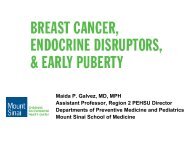
![February 3, 2013 [PDF] - Mount Sinai Hospital](https://img.yumpu.com/50584982/1/190x245/february-3-2013-pdf-mount-sinai-hospital.jpg?quality=85)
![March 18, 2012 [PDF] - Mount Sinai Hospital](https://img.yumpu.com/50462098/1/190x245/march-18-2012-pdf-mount-sinai-hospital.jpg?quality=85)
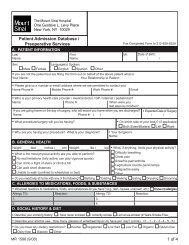
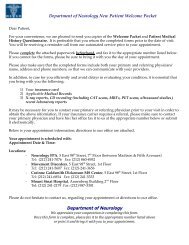
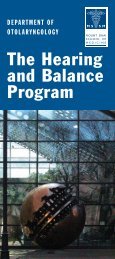
![Partners Program Guide [PDF] - Mount Sinai Hospital](https://img.yumpu.com/49411954/1/190x245/partners-program-guide-pdf-mount-sinai-hospital.jpg?quality=85)
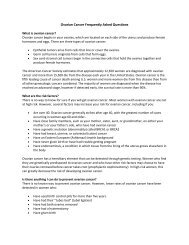
![PGY-1 Residency Application [PDF] - Mount Sinai Hospital](https://img.yumpu.com/48577701/1/190x245/pgy-1-residency-application-pdf-mount-sinai-hospital.jpg?quality=85)
